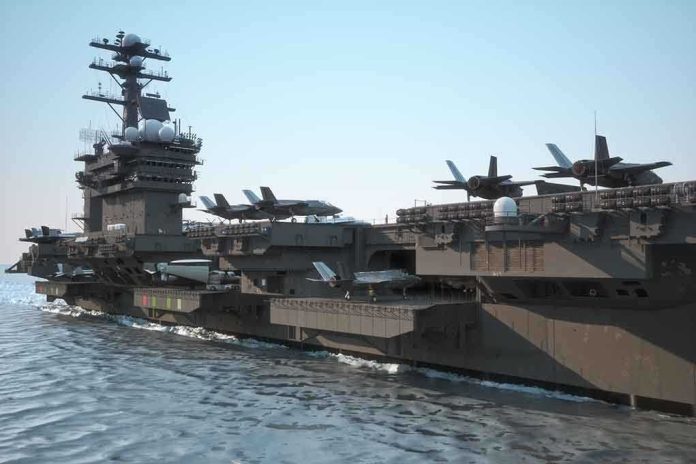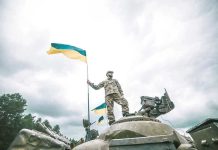
U.S. Navy and Coast Guard forces seized over 7,850 pounds of cocaine worth $58.1 million in a dramatic offshore drug bust, demonstrating President Trump’s administration’s unwavering commitment to border security and the fight against international drug trafficking.
Key Takeaways
- U.S. Navy and Coast Guard captured three suspected drug smugglers transporting nearly 4 tons of cocaine valued at $58.1 million in the Eastern Pacific
- The USS Sampson, an Arleigh Burke-class guided-missile destroyer deployed from Naval Base San Diego, played a crucial role in the counter-narcotics operation
- The operation began when a Navy helicopter identified suspicious behavior from a vessel, leading to the Coast Guard detachment’s successful interdiction
- The suspected smugglers claimed non-U.S. nationality and were taken into custody aboard the USS Sampson
- This seizure aligns with the Trump administration’s broader efforts to combat drug trafficking, including sanctions against Mexican banks and significant seizures of fentanyl
Major Drug Bust Highlights Naval Defense Excellence
In a significant blow to international drug traffickers, U.S. naval forces successfully intercepted a massive cocaine shipment in the Eastern Pacific Ocean. The operation, conducted by personnel aboard the USS Sampson, resulted in the seizure of more than 7,850 pounds of cocaine with an estimated street value of $58.1 million. This substantial drug bust underscores the effectiveness of President Trump’s directive to maintain aggressive counter-narcotics operations in international waters, protecting American communities from the devastating impacts of illegal drug trafficking.
The interdiction began when a Navy helicopter crew spotted a suspicious vessel displaying concerning behavior. Following standard protocol, a U.S. Coast Guard Law Enforcement Detachment team deployed from the USS Sampson to investigate. Upon boarding the vessel, authorities discovered the enormous cocaine cache and apprehended three individuals who claimed non-U.S. nationality. The suspects were taken into custody aboard the USS Sampson, while their vessel, deemed a “hazard to navigation,” was subsequently sunk according to maritime procedures.
Strategic Deployment Supporting Border Security
The USS Sampson, an Arleigh Burke-class guided-missile destroyer, was deployed from Naval Base San Diego on June 3 specifically to support border security and counter-narcotics efforts. This deployment demonstrates the Trump administration’s comprehensive approach to national security, utilizing naval assets to intercept illegal substances before they can reach American shores. The ship’s advanced capabilities, including helicopter operations and the ability to host specialized Coast Guard teams, proved essential to the success of this high-stakes mission.
This operation represents just one component of a broader strategy to combat the influx of illegal drugs into the United States. Under President Trump’s leadership, federal authorities have implemented a multi-faceted approach that includes enhanced maritime interdiction, border security measures, and diplomatic pressure on source countries. The administration has demonstrated its seriousness by imposing sanctions on Mexican banks involved in laundering drug money and orchestrating major seizures of dangerous substances like fentanyl and methamphetamine.
Coordinated Efforts Between Military Branches
The successful interdiction highlights the effective coordination between different branches of America’s defense forces. While the USS Sampson provided the platform and initial detection capabilities, it was the specialized Coast Guard Law Enforcement Detachment that conducted the actual boarding and seizure operation. This seamless integration of Navy and Coast Guard assets exemplifies how military cooperation can achieve significant results in combating transnational criminal organizations that threaten American security and public health.
The Eastern Pacific region has long been a primary transit zone for cocaine shipments heading to the United States from South America. Drug trafficking organizations often use fast boats, semi-submersibles, and even makeshift submarines to transport their illegal cargo through these waters. The constant presence of U.S. naval assets in this region serves as both a deterrent and an active countermeasure against these criminal enterprises, disrupting supply chains and driving up costs for drug cartels attempting to flood American communities with dangerous substances.
Part of a Larger Counter-Narcotics Strategy
This impressive drug seizure comes amid ongoing efforts by the Trump administration to strengthen America’s response to the drug trafficking crisis. By combining military interdiction with diplomatic pressure, economic sanctions, and enhanced border security measures, the administration has created a comprehensive approach to addressing the drug crisis. The Eastern Pacific operation demonstrates that American forces remain vigilant and capable of disrupting major drug shipments before they can reach our shores and harm our citizens.
As drug cartels continue to evolve their tactics and seek new routes to smuggle their products, America’s defense forces are adapting accordingly. The successful operation by the USS Sampson and its Coast Guard detachment proves that our military maintains the flexibility, intelligence capabilities, and tactical expertise necessary to counter these threats effectively. The interdiction of nearly four tons of cocaine represents not just a tactical victory but a significant strategic blow against the financial infrastructure of international drug trafficking organizations.







